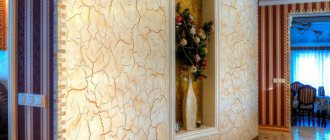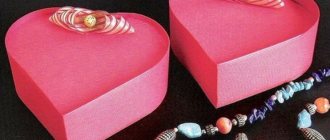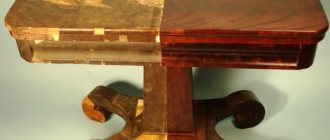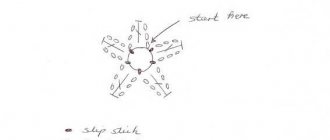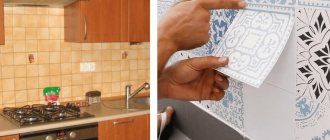Why do these coatings glow?
A special pigment provides the glow of fluorescent paint; The fluorophore converts and transmits the ultraviolet rays it absorbs into the visible part of the spectrum.
Fluorophores are usually represented by substances such as rhodamines, as well as aminonaphthalimide derivatives. Since these components are too expensive in their pure form, they paint the smallest particles of a polymer dispersion, obtaining that special, fluorescent pigment that is added to the base of the material during paint production.
Such a coating is not capable of absorbing and storing light, unlike luminescent paints that glow in the dark without any external influence. They contain another active substance - a phosphor, and these paints are otherwise called neon. Fluorescents only reflect the rays of the sun or the light of ultraviolet lamps.
Scope of use
Luminescent paint is used in different areas:
- in decorative finishing of restaurants, cafes, night clubs;
- for painting various furniture, for example, chairs, tables, sofas;
- when creating makeup elements, theatrical costumes, and various stage attributes;
- in flower compositions – both artificial and real;
- in the textile industry, for creating designs, logos and other elements on clothing;
- for painting various wooden structures, for example, outdoor gazebos, window frames, exterior items;
- in tuning bicycles, motorcycles and cars;
- in the manufacture of special services clothing;
- in the production of road markings and signs.
Today, luminous paints are often used for decorative decoration of premises. This dye can be applied to walls, ceilings, as drawings or patterns; they will only appear at night when the lights are off. Many designers advise using different colors of luminescent paint to create an original, attractive interior design at home.
Areas of use
Modern man almost every day observes a large number of objects with a fluorescent coating.
Outside the home
- road markings, signs and markers, parking lots and runways;
- signs for cafes and shops;
- billboards;
- building facades with lighting and appropriate finishing, stained glass;
- graffiti;
- airbrushing on cars, inscriptions on special-purpose vehicles;
- interior design of nightclubs and restaurants.
At home
- finishing of walls and multi-level ceilings in bedrooms;
- creating a fabulous atmosphere in children's rooms;
- restoration and stylization of outdated pieces of furniture.
If an artist is involved in applying the luminous pattern, then the apartment will literally sparkle with new colors, completely transforming in the evening and at night. However, you can add a few simple elements to the interior using luminous compounds yourself.
DIY reflective paint can also be made, and this is another option to get light in the dark
Handmade
- panels or paintings,
- Christmas tree decorations and garlands,
- figurines, dolls, keychains, etc.
Body painting
- Temporary tatoos,
- body art,
- face painting
This type of painting is used as entertainment at children's parties and attractions, as well as at stylized parties or masquerades. To work on the body, a special composition of glycerin, lanolin and fluorescent pigment mixed with water is used.
Important: before applying paint to the body, it is necessary to conduct an allergy test by making a small smear on the inner elbow and wait about half an hour. If there is no reaction in the form of itching or redness, then you can begin to create the main drawing.
This composition can be easily washed off using body scrub products or warm water and soap.
Other Applications
- in the textile industry to create ornaments or images on clothing items;
- for illuminating living plants during night events;
- in show business and film industry.
And this is not the entire list.
Where are fluorescent paints used?
The material is used to decorate the interior and exterior surfaces of buildings. Also, using luminous enamel, you can easily decorate any object with your own hands, creating a unique decoration for your home or a gift for a friend. Having artistic talent, you can paint a unique picture with fluorescent paint that will decorate an interior wall or facade. Most often, such solutions are used in the decor of nightlife establishments - clubs, restaurants, etc.
Fluorescent paintings can become the “highlight” of the interior
At the same time, you can “highlight” almost anything. Various types of fluorescent coatings are suitable for painting:
- metal (car bodies and wheels, road signs, decorative and artistic objects);
- fabrics (clothing, promotional items and textile souvenirs);
- glass and ceramics (dishes, stained glass, ceramic tiles);
- human body (body art) and living plants;
- wood (fences, gazebos, windows, doors);
- stone and concrete (walls, stairs, paths, facade cladding);
- plastic (polypropylene, polystyrene, polycarbonate and PVC products).
Attention! Before you make a luminous pattern on any surface, you need to make sure that the chosen paint is suitable for it. For example, for body art you can only use safe water-based acrylic dispersions.
Safe water-based compounds are used for body art
Types of luminous paints
Fluorescent paints vary in composition and purpose. The materials can be divided into three groups.
Acrylic composition for interior work
Fluorescent acrylic paint for interior decoration has the following advantages:
- you can mix materials of several colors to create the desired shade;
- the composition has no unpleasant odor and is absolutely non-toxic;
- the coating is suitable for wooden and plastered surfaces, fits well on drywall.
Flaws:
- low moisture resistance,
- Not suitable for painting metal and plastic surfaces.
These compositions are ideal for the walls of a bedroom or living room, but renovations in the bathroom are best done using other means.
Facade acrylic paints
The use of acrylic fluorescent paints for facade work is a wonderful way to give a building a festive and solemn look, especially since these materials have excellent quality characteristics:
- increased resistance to temperature changes,
- moisture resistance;
- abrasion resistance;
- high vapor permeability, no odor;
- good adhesion to almost any type of surface, including plastic, galvanized metal, concrete and others;
- The coating is not afraid of treatment with detergents.
If the material is purchased to create a light picture on the wall, then before starting work it is usually diluted with water.
Universal compositions based on urethane-alkyd
Aerosol paints in cans are used on various surfaces, and even on glass. The coating is very resistant to the negative effects of external factors. Those who do airbrushing for cars work with these paints. If someone dreams of a fluorescent bathroom or toilet with luminous designs, then spray paints are the most suitable option.
“Invisible” paints
Invisible fluorescent paint is practically unnoticeable in daylight on light surfaces, but on dark ones it can be detected in the form of whitish stains. This material is used both for the execution of unusual design solutions and for night illumination of road signs.
Invisible paint, paradoxically, has a rich color palette. Walls or ceilings, completely ordinary during the day, are magically transformed in the evening or at night: in the ultraviolet light of the lamps, intricate ornaments or romantic landscapes appear on their surfaces.
“Visible” paints during the day are practically no different from other paints and varnishes, since their glow also becomes noticeable only under ultraviolet rays against a background of darkness or twilight.
Features of fluorescent paint
Fluorescent enamels contain inks that emit visible radiation under ultraviolet rays. In daylight or artificial light, such paint remains transparent or colored. The strength and shade of the glow depend on the components of the composition and the color of the coloring pigment.
Painted elements do not glow in the dark. When ultraviolet light hits them, they turn neon. Fluorescent enamels are produced on a water-acrylic or alkyd base, which makes them universal for various materials (fabric, paper, concrete, leather, wood, metal, etc.).
Other properties of such paints:
- without smell;
- do not contain toxic substances;
- dry quickly;
- do not crack from water;
- fade in the sun if they do not contain UV filters;
- do not ignite;
- are used economically.
Please note: Magnetic paint
General disadvantages
- Unfortunately, coatings cannot fluoresce forever, since they have rather poor resistance to direct sunlight. You can avoid rapid fading by using protective agents, such as clear varnishes. When purchasing such a composition, it is important to make sure that it does not have matting properties, which will significantly reduce the glow effect.
- The texture of the fluorescent dispersion does not allow achieving a glossy surface finish. When such a need arises, you can resort to the method described in the previous paragraph.
- The material does not belong to heat-resistant compounds. Destroys at a temperature of +100-150 °C.
How to make it yourself
To create glowing paint, you need to mix just two components:
- clear acrylic varnish;
- fluorescent pigment in powder form, which can be purchased in a specialty store or online.
It is advisable to immediately select the second ingredient by color - the colorless polymer pigment largely loses its fluorescent properties when tinted.
Take one part of powder for four parts of varnish, mix the composition thoroughly, and after that you can begin the painting process.
Application rules and technology
Depending on the relief and size of the surface to be painted, a brush, roller, swab, or spray gun are used to apply fluorescent paint. The emulsion can also be simply poured onto the desired area, or if the object to be painted is small, dip it into the jar. Fluorescent aerosol paints are sprayed directly from the can.
In any case, when applying the material, adhere to the following recommendations:
- Clean the surface to be painted from dust and dirt, for example, wash it with soap and water or soda, and then dry it well.
- Stir the paint thoroughly before use. The water-based emulsion must be slightly diluted (to do this, add up to 10% water to it). The aerosol can is shaken for about two minutes before spraying.
Before starting work, fluorescent paint must be mixed
- They operate at temperatures from +5 °C.
- Apply the material in two to three thin layers. To obtain an even coating, move the brush and roller first in one direction, and then perpendicularly. Aerosol paint is sprayed with smooth movements from a distance of 30 cm.
On a note! To create a luminous design with your own hands, it is convenient to use stencils or stamps. If a more complex picture is needed, it is first drawn with a pencil and only then painted.
- Each layer is given time to dry for 3–3.5 hours (at a temperature of about 20 ° C).
- After applying the last layer, leave the painted surface until completely dry (this will take approximately 24 hours).
Coloring
In application, fluorescent acrylic paints are practically no different from similar compositions without a “magic” pigment. If we are not talking about an aerosol, then the following tools will be required:
- brushes,
- paint roller,
- tray,
- You can also use a spray gun.
Fluorescent dyes are usually applied in two layers. The more layers, the brighter the glow effect will be. The time interval between staining should be at least three hours. Complete drying occurs within a day.
The coloring agent must be stored in a tightly closed container, so the best option for long-term storage is paint in cans.
Characteristics of fluorescent coatings
In addition to the unusual ability to glow, this paint has other features. The most important of them:
- Low light fastness. Fluorescent dyes fade quite quickly when exposed to light (especially when used outdoors). To protect pigments from fading, a special modifier that absorbs UV rays is added to the dispersion. Or the finished coating can simply be coated with clear varnish on top. But in both cases, the brightness of the pattern decreases.
On a note! Fluorescent paint becomes especially unstable after self-tinting. Therefore, if the durability of the coating is very important, it is better to purchase ready-made colored material.
Each type of fluorescent coatings has its own characteristics and characteristics
- Grain. Since the pigment grains are quite coarse, they do not allow for a thin glossy finish. To solve this problem, paint is applied in two layers or varnished.
- Thermal instability. Fluorescent coatings begin to decompose already at +150…250 °C. At the same time, they lose their ability to glow.
